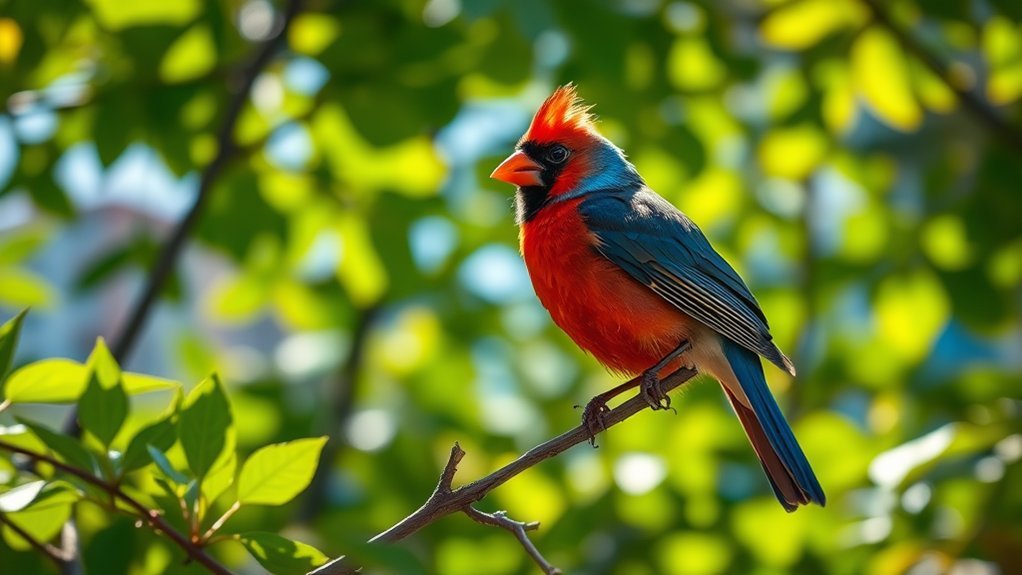Blue Cardinals: Myth Vs Reality Explained
You may have heard stories about blue cardinals being good omens or messages from spirits. However, their true origin is different. Blue cardinals are not a distinct species; they get their blue color from a genetic mutation.
This variation is fascinating. Blue cardinals are similar to their common relatives but stand out due to this unique trait. Understanding this difference helps us appreciate both the beauty and complexity of these birds.
What other myths or truths could be hiding in plain sight? Explore and discover more about the wonders of nature.
Key Takeaways
- Blue cardinals are actually a rare color variation of the Northern Cardinal, not a distinct species.
- Their blue color comes from a genetic change that affects feather color, not from magical forces.
- Some people believe blue cardinals bring good luck, but they are simply birds with a unique appearance.
- Protecting their habitats is important, as all cardinals, including blue ones, face threats from habitat loss.
- You can help support cardinal populations by planting native plants and using fewer pesticides.
The Fascination With Blue Cardinals

Blue cardinals fascinate birdwatchers and nature lovers. Their unique color draws attention, and it symbolizes calmness and reflection. This relaxing presence makes them special.
To spot these beautiful birds, try birdwatching early in the morning and focus on fruit-bearing trees where they tend to gather. Watching their behaviors adds excitement to the experience.
The rarity and beauty of blue cardinals create a strong connection among those who enjoy observing them. Each sighting feels like a shared success, bringing joy to every birdwatcher.
The Biological Basis of Cardinal Coloration
Cardinals have bright colors due to specific biological processes. Their vivid appearance mainly comes from carotenoid pigments found in their diet. These pigments mix into their feathers, creating the rich reds we admire.
The feather arrangement can also reflect light in a way that makes their colors more intense. Additionally, tiny features in the feathers affect how light interacts with them, adding to their beauty.
This combination of pigments and feather structure shows their health and vitality, helping them connect with other cardinals. Learning about these processes helps us appreciate the true beauty of cardinals.
Understanding the Blue Mutation

Blue cardinals are a rare sight that intrigue bird watchers and nature lovers. These birds exhibit a unique color mutation linked to the blue gene. This mutation changes their usual red feathers to blue.
It affects how color-producing proteins function and alters light interaction with their feathers, resulting in vibrant blue colors that stand out from the typical red.
This phenomenon invites curiosity and appreciation for these birds. The rarity of blue cardinals draws in enthusiasts, fostering a community passionate about nature and its wonders.
Understanding this mutation allows bird lovers to deepen their connection to wildlife and explore the fascinating world of genetics in birds.
Myths Surrounding Blue Cardinals
Many bird watchers admire blue cardinals for their striking appearance. However, various myths exist about them that can confuse people about their true nature.
- Some believe that blue cardinals bring good luck or have special meanings.
- Others think they're a rare type of bird that may soon disappear.
- Some feel they're the spirits of loved ones watching over us.
In truth, blue cardinals are simply a rare color variation of the Northern Cardinal. They aren't magical beings but regular birds with unique coloring.
The Role of Environmental Factors

The vibrant blue coloring of cardinals is influenced by their environment. Their habitat affects their appearance.
Cardinals live in various locations, such as forests and cities. If they're in areas with specific plants, these plants provide dietary pigments that enhance their color.
Climate also plays a role. Changes in temperature can alter their breeding cycles and food supply, impacting their color.
Observing cardinals in different settings shows how their looks relate to their surroundings. Understanding these connections helps us appreciate the beauty of cardinals and their unique traits.
Identifying Blue Cardinals: What to Look For
To identify blue cardinals, look for several key features that distinguish them from red cardinals.
Key characteristics:
- Bright blue feathers that catch the light.
- Black markings on the face that highlight their features.
- Wings and tail feathers may show slight gray tones.
These traits will help you spot blue cardinals easily.
Enjoy observing these unique birds!
Observing Blue Cardinals in the Wild
As you explore the woods or your backyard, stay alert for the blue cardinal. Spotting this beautiful bird can be an exciting experience. To increase your chances of seeing a blue cardinal, consider these tips.
Start your birdwatching in the early morning. This is the best time to see them, as they're most active then. Bring binoculars to observe them closely, and look for movement in the trees where they often hide. Listen for their unique calls, which can help you find them.
Settle into a quiet spot and let nature come to you. Take notes on what you see, including their behavior and interactions with other birds.
Share your interest in birdwatching with fellow enthusiasts, and connect over your admiration for these stunning creatures.
Conservation and Protection of Cardinal Species
Cardinal species, like the Northern Cardinal, are colorful and important. Their numbers are declining due to habitat loss and environmental changes. Protecting these birds is essential.
You can help by:
- Supporting habitat protection,
- Planting native gardens that attract cardinals,
- Joining local conservation efforts.
Urban development, pesticides, and climate change threaten these birds. By participating in conservation initiatives and promoting bird-friendly policies, you can make a difference.
Every small action counts, such as:
- Reducing pesticide use,
- Creating green spaces.
Together, we can create environments where cardinals thrive. This ensures future generations will enjoy the beauty of these birds. Let's work towards their protection and resilience against ongoing challenges.
Frequently Asked Questions
Are Blue Cardinals Common or Rare in Nature?
Blue cardinal sightings are very rare. These birds primarily inhabit wooded areas and parks. Their elusive nature makes each sighting feel special. Spotting a blue cardinal can create a memorable connection with nature.
Can Blue Cardinals Be Found Outside North America?
Blue cardinals cannot be found outside North America. They live only in that region. While they may migrate within certain areas, they do not change their habitats to other continents. This limits their presence globally.
How Do Blue Cardinals Interact With Other Bird Species?
Blue cardinals show interesting behaviors in courtship and feeding. They compete for food and set territories, leading to unique interactions with other bird species in your area. These behaviors can be observed during mating season and feeding times. Watching these exchanges can enhance your understanding of local bird dynamics and create an engaging birdwatching experience.
Are Blue Cardinals More Aggressive Than Typical Cardinals?
Blue cardinals show similar territorial behavior and feeding habits as regular cardinals. They become aggressive mainly when protecting their nests. However, their level of aggression does not significantly surpass that of typical cardinals. Both types of cardinals defend their territories with similar intensity during nesting season. Overall, blue cardinals are not notably more aggressive than their common counterparts.
What Are the Best Times to Observe Blue Cardinals?
Blue cardinals are most visible in the early morning and evening. These times provide good light and quieter surroundings. You can easily spot them while they feed or socialize during these hours.

Kashvi is a passionate bird enthusiast and nature lover who has been fascinated by the world of birds for years. With a keen eye for detail and a love for learning, Kashvi is dedicated to sharing her knowledge and insights with fellow bird enthusiasts on Avian Enthusiasts. Through her engaging and informative articles, Kashvi aims to inspire others to join her in exploring the fascinating world of birds and to promote a deeper appreciation for these incredible creatures.







